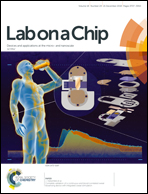The size dependant behaviour of particles driven by a travelling surface acoustic wave (TSAW)†
Abstract
The use of travelling surface acoustic waves (TSAW) in a microfluidic system provides a powerful tool for the manipulation of particles and cells. In a TSAW driven system, acoustophoretic effects can cause suspended micro-objects to display three distinct responses: (1) swirling, driven by acoustic streaming forces, (2) migration, driven by acoustic radiation forces and (3) patterning in a spatially periodic manner, resulting from diffraction effects. Whilst the first two phenomena have been widely discussed in the literature, the periodic patterning induced by TSAW has only recently been reported and is yet to be fully elucidated. In particular, more in-depth understanding of the size-dependant nature of this effect and the factors involved are required. Herein, we present an experimental and numerical study of the transition in acoustophoretic behaviour of particles influenced by relative dominance of these three mechanisms and characterise it based on particle diameter, channel height, frequency and intensity of the TSAW driven microfluidic system. This study will enable better understanding of the performance of TSAW sorters and allow the development of TSAW systems for particle collection and patterning.



 Please wait while we load your content...
Please wait while we load your content...